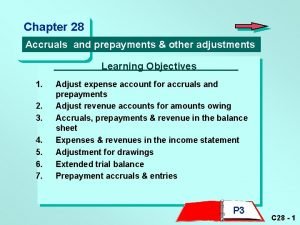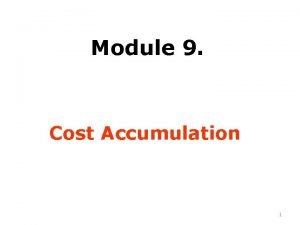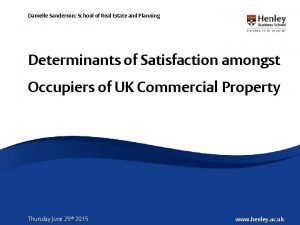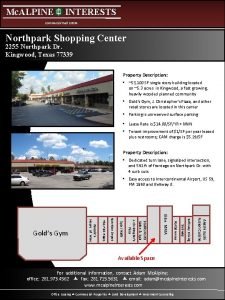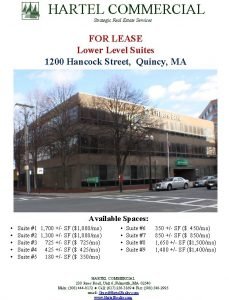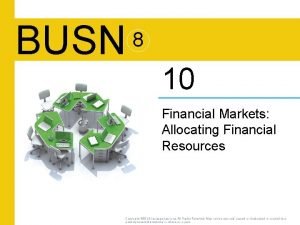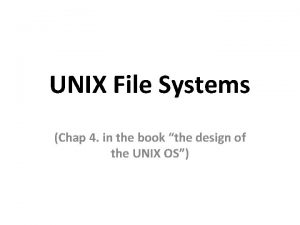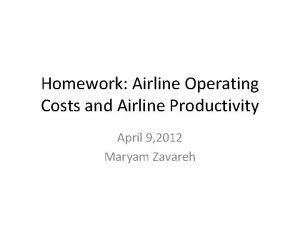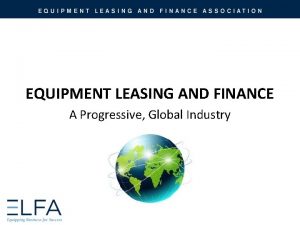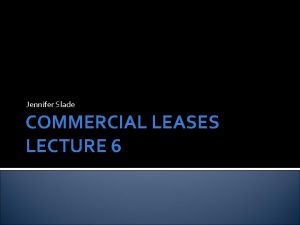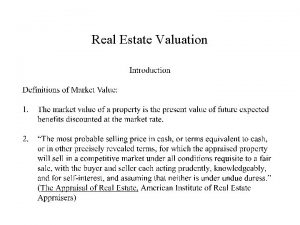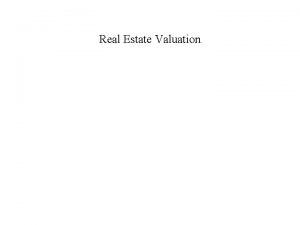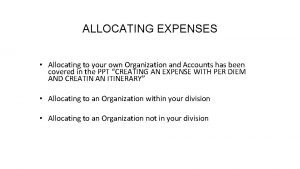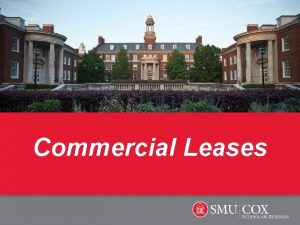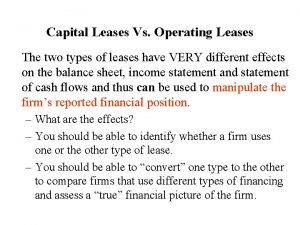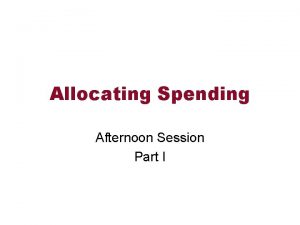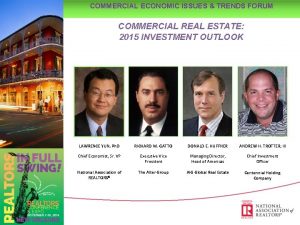ALLOCATING OPERATING EXPENSES IN COMMERCIAL REAL ESTATE LEASES
















- Slides: 16

ALLOCATING OPERATING EXPENSES IN COMMERCIAL REAL ESTATE LEASES: NEGOTIATING STRATEGIES FOR LANDLORDS AND TENANTS Scott D. Brooks, Cox Castle & Nicholson Christine R. Norstadt, Pursley Friese Torgrimson August 4, 2016

Outline of Presentation • Brief overview of different types of lease structures • Standard operating expense inclusions and exclusions • Gross-up provisions • Expense cap provisions • Audit rights of landlord operating costs 2

Different Types of Lease Structures • • “Net Leases” ― Typical in retail and industrial; less common in office. ― In single tenant context, may allocate responsibility for work to Tenant, at Tenant’s cost. Base Year (or “Full Service Gross”) Leases ― Typical in office leasing and sometimes in industrial. ― Base Year is typically the first calendar year where there is 6 months after Commencement Date (so June 30 Commencement Date is typical cut off to move to next calendar year for Base Year). ― Use of different categories to lessen impact of cost spikes in taxes, utilities or insurance costs. ― Expense stop leases (using fixed amount as base rather than actual costs for a particular year). 3

Different Types of Lease Structures • Gross Leases ― • Hybrid (e. g. , Net for Electricity or Janitorial) ― • Mostly used in short term leases/licenses. Utility cost spikes have resulted in some landlords taking electrical costs out of Base Year. Fixed Contributions ― Increasingly common in regional malls and mixed use projects to simplify cost allocations/disputes. 4

Standard Operating Expenses Inclusions and Exclusions • Included items ― General: costs of operation, management, ownership, maintenance and repair of the Project, as determined by accepted principles of sound accounting practice. ― Utility costs and costs of janitorial, security and other services. ― Insurance costs and deductibles. ― Project management including management personnel costs, management office rental and management fees. ― Costs of repairs, maintenance and replacements including costs of supplies, materials, equipment and tools required therefor. 5

Standard Operating Expenses Inclusions and Exclusions • Excluded items ― Capital expenditures - Complete exclusion or Limited inclusion with amortization of costs ― Ground lease rent and mortgage related costs. ― Costs reimbursed by insurance, warranties or other third parties. ― Costs of build out of tenant spaces and leasing costs including marketing, attorneys’ fees and broker commissions. ― Depreciation or amortization (but see capital expenses). ― Expenses in connection with services or amenities not available to Tenant or for which Tenant is separately charged. ― Amounts paid to Landlord affiliates in excess of market rate for goods or services. ― Landlord’s overhead or administrative costs such as personnel costs above the level of Building manager. 6

Gross Up Provisions • The purpose of a “gross up” provision is to allocate to a tenant only the amount of operating expenses which is properly attributable to the tenant’s occupancy of the building. Negotiating for a gross up is appropriate where the tenant is paying for its share of operating expenses over a base year amount. • When to negotiate for a gross up provision: Base Year Occupancy Landlord Low Occupancy High Occupancy ― Tenant X X Regardless of who initiates the negotiation, grossing up results in a fair allocation of expenses for both landlord and tenant 7

Gross Up Provisions • • A typical gross up provision permits the landlord to, for accounting purposes, increase (or gross up) the amount of variable operating expenses to reflect 90% to 100% building occupancy ― Variable expenses (e. g. , janitorial, utilities) ― Non-Variable (e. g. , property taxes) A fair gross up provision should: ― State that the landlord cannot recover more than 100% of actual expenses ― Stipulate that the gross-up applies only to variable expenses and defines “variable expenses” ― Provide that the base year and all subsequent years must be “grossed up” and the percentage should be clearly stated (typically between 90% and 100%) 8

Gross Up Provisions • Example of Gross Up Provision Benefitting Landlord 100% Gross Up No Gross Up Base Year Two Actual Variable Operating Expenses $90, 000 $75, 000 Building Occupancy 90% 70% Grossed-Up Variable Expenses $100, 000 $701, 143 --- Tenant’s Pro Rata Share 70% 70% Tenant’s Operating Expense Payment (Variable) --- $5, 000 --- $0 9

Gross Up Provisions • Example of Gross Up Provision Benefitting Tenant 100% Gross Up No Gross Up Base Year Two Actual Variable Operating Expenses $21, 250 $90, 000 Building Occupancy 25% 90% Grossed-Up Variable Expenses $85, 000 $100, 000 --- Tenant’s Pro Rata Share 25% 25% Tenant’s Operating Expense Payment (Variable) --- $3, 750 --- $17, 188 10

Expense Caps • Typically, caps apply only to controllable operating expenses, such as landscaping and cleaning expenses • A well drafted expense cap provision should: ― Clearly describe how the cap is to be computed and applied ― Identify what types of expenses will be capped and clearly define those expenses if there is a limitation (e. g. , “controllable operating expenses”) ― Include a sample computation 11

Expense Caps • • Compounded Year Over Base Cap (a/k/a “compounded and cumulative” cap) ― Cap percentage is compounded each year, allowing for a more rapid increase in the capped expenses ― Landlord-friendly because it allows for the fastest increase in capped expenses, permitting the landlord to pass through more expenses to the tenant. Example: If base year expenses are $100, 000 and the parties have agreed to a cap of 4% over the base year expenses on a compounded basis, the caps are calculated as follows: ― Base year expenses: $100, 000 ― Year 2 capped expenses: $100, 000 x 1. 04 = $104, 000 ― Year 3 capped expenses: $100, 000 x 1. 0816* = $108, 160 *Represents a 4% increase over the prior year’s 4% cap. Year 4’s cap will be 4% over the Year 3 cap percentage, and so on. 12

Expense Caps • Year Over Year Cap • • Keyed to actual, prior year expenses and could therefore result in lower caps Example: If actual base year expenses are $100, 000 and the parties have agreed to a cumulative year over year cap of 4%, the caps are calculated as follows: ― ― Base year actual expenses: $100, 000 ― Year 2 capped expenses: $100, 000 x 1. 04 = $104, 000 If Year 2 expenses are actually $102, 000, and the cap is not reached, then the parties will calculate the Year 3 capped expenses based on the $102, 000 in actual Year 2 expenses: ― ― Year 3 capped expenses: $102, 000 x 1. 08 = $110, 160 If Year 2 expenses are $106, 000, however, then the Year 2 cap will apply, and the parties will calculate the Year 3 capped expenses based on the $104, 000 cap for Year 2: ― Year 3 capped expenses: $104, 000 x 1. 08 = $112, 320 13

Expense Caps • Variations on Expense Caps • Cumulative Year Over Base • Compounding Year Over Year • Landlord may negotiate to recover “unused” percentage increases (in a year in which expenses are below the cap) by making up the difference later in the term if operating expenses increase above the cap 14

Audit Rights • • Landlord considerations ― Limit the timing of the audit (e. g. , notice of the audit must be given within ___ days of the year-end reconciliation) ― Limit scope of audit (shorter “look back” period) ― No auditors paid on contingency ― Location of the audit Tenant considerations ― Understand the time limitations ― Negotiate for landlord to pay for audit if landlord has overcharged by __% or greater 15

Questions and Discussion Scott D. Brooks, Esq. Cox, Castle & Nicholson LLP 50 California Street, Suite 3200 San Francisco, California 94111 Phone: (415) 215 -4962 Email: sbrooks@coxcastle. com Christine R. Norstadt Pursley Friese Torgrimson LLP 1230 Peachtree Street, Suite 1200 Atlanta, Georgia 30309 Phone: (404) 876 -4880 Email: cnorstadt@pftlegal. com 16
 Accrued and prepaid expenses
Accrued and prepaid expenses Direct expenses vs indirect expenses
Direct expenses vs indirect expenses Sanderson commercial real estate
Sanderson commercial real estate Alpine commercial real estate agent
Alpine commercial real estate agent Strategic real estate services
Strategic real estate services Allocation map
Allocation map Markets allocating resources
Markets allocating resources Ialloc algorithm in unix
Ialloc algorithm in unix Real homes real estate
Real homes real estate Airline operating expenses
Airline operating expenses Airline operating expenses
Airline operating expenses Brock corp reports operating expenses
Brock corp reports operating expenses Commercial and non commercial food service
Commercial and non commercial food service Commercial operating system
Commercial operating system Operating lease
Operating lease Ifrsbox leases
Ifrsbox leases Types of leases
Types of leases
